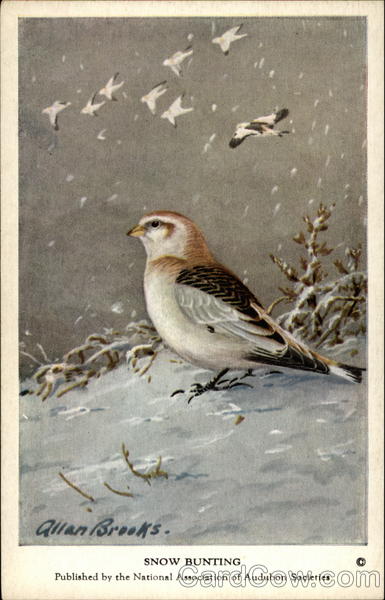Front:
allan Breeks.
SNOW BUNTING
Published by the National Association of Audubon Societies
Back:
No. 38 Snow Bunting
Length 7 inches
Snow Buntings or Snowflakes belong to that
small group of birds which, like the Shore Lark
and the Lapland Longspur, come drifting down
before the smiting blasts of winter. This species
is most appropriately named, for it is the only
member of the Sparrow family in which white
predominates on all its body. The birds, indeed,
seem like animated snowflakes as they quietly set-
tle down in large flock3 to feed in the glow-clad
fields. Snow Buntings feed entirely on seeds, of
which they seem to find a plentiful Supply no mat-
ter how deep the snow or sevete the weather.
They are rather restless and active lørds, starting
up on the slightest provocation, as though tossed
into the air, after which they go Wheeling across
the country to alight in somgufresh foraging
ground.
They sometimes sing Cheerily when flying
through the chill blasts. With the disappearance
of the snow these birds return again to their far
northern home.
The nest is of grass moss and lined with
feathers. From three for five eggs are laid, pale
greenish-white, speckled with brown.
Classification: Order Passeres. Family Fringillide.
Scientific name: Plectrophenax nivalis.
Range: Throughout the northern parts of the North-
ern Hemisphere. In North America it breeds from
Labrador and Hudson Bay northward. Winters irregu-
larly south into northern United States.
No. 38 from set of 50 Winter Birds of the Northeastern United
States. Published by the National Association of Audubon So-
cieties, 1974 Broadway, New York City. Price per set, in a box,
$1.00 post paid.
PEALEO ALAVE
WELRAING



